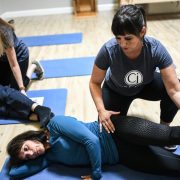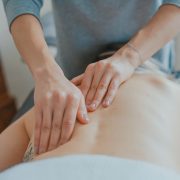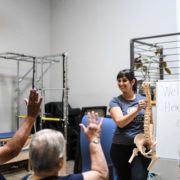Hamstrings Always Tight? This Could be Why
If you’ve ever felt tightness in your hamstrings, the typical advice you get from friends, family, and even well-meaning healthcare professionals is to stretch them.
But if even your stretches just aren’t working – what then?
You hear me say this a lot… but if you’re constantly stretching… or even foam rolling a tight or tense muscle… and nothing seems to change… then it’s time to start considering that it might be something else.
I see this scenario ALL the time in our office…
Just recently, a gentleman (we’ll call him “Steve”) came to us with what he thought was a “chronic hamstring strain…”
He had been stretching his hamstrings consistently – but they just weren’t loosening up.
He wanted to know if there were better stretches he could be doing to loosen up the tight, uncomfortable feeling he was experiencing in the back of his thigh every day.
First – it was critical to make certain that Steve’s problem was… in fact… a tight hamstring.
If the chronic tightness in the back of Steve’s thigh was due to a hamstring problem, his stretches really should’ve been having some sort of impact.
Instead, the stretches either did nothing… or made his thigh ache.
Sometimes after stretching a lot – he would “feel” his hamstring for the rest of the day – even when he was just sitting. We checked that he was using proper stretching technique – and he was – so something wasn’t right.
When you’re having a problem with your muscle – and only your muscle – you’ll experience discomfort, tightness, or pain when you’re either using that muscle or stretching that muscle.
Otherwise – you should generally feel perfectly fine.
Muscles are made up of what we call contractile tissue. When you truly strain a muscle, this contractile tissue gets disrupted. You heal it by moving and stretching it – and eventually it goes back to normal. On occasion, people don’t move enough after a muscle strain and the tissue can become chronically tight. But still, you would only experience that tightness when trying to use or stretch the muscle.
This wasn’t the case for Steve.
His pain would, on occasion, linger throughout the day when he was resting or sitting. Sometimes he’d notice hamstring discomfort at night when he was trying to sleep.
Steve was feeling symptoms in his hamstring whether he was using that muscle or not – and his stretches weren’t helping.
This immediately tells me that there was another problem causing his symptoms and it was more than just a tight hamstring. – and when hamstring or thigh tightness doesn’t respond to stretching or exercise – we must always consider the lower back.
Since Steve wasn’t feeling any pain in his lower back – he never considered this himself.
But the key was in how Steve’s pain was behaving…
Your pain behaves in different ways depending on where it’s coming from..
As I mentioned previously, when your muscle is the source, your pain behaves in a very specific and repeatable manner.
But if pain is coming from your spine, it can quite literally be all over the place.
You can feel symptoms in your back, your butt, and your limbs. You’ll have good days and bad days. You’ll feel symptoms at rest, and you can certainly feel tightness in your hamstring – just like Steve.
The other interesting thing about problems that originate from the spine is that you’ll often be able to trigger your symptoms by moving your spine.
When we investigated Steve’s spine… we found that when he moved a certain way over and over… it would produce his hamstring tightness.
Bingo!
This explains why Steve’s hamstring stretches were doing absolutely nothing… He was stretching his thigh when he really needed to stretch his back.
Does Steve’s story resonate with you?
If you’re feeling chronic tightness or pain in your hamstring that just isn’t going away – chances are good that you’re missing something.
Do yourself a favor… DON’T check YouTube or “Dr. Google” for advice…
Talk to one of our experts instead.
Best way to do that is request a FREE Discovery Session.
We’ll talk to you about the symptoms in your hamstring and let you know if stretching is enough… or if you need something more!
CLICK HERE to request a Free Discovery Session with one of our specialists.











